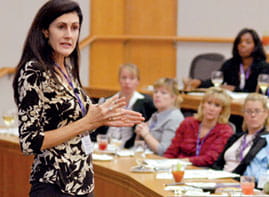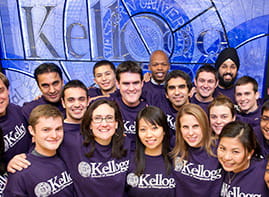Graduates discuss the latest in ‘customer-centric innovation’ at Kellogg Centennial conference in Miami
1/22/2009 - Kellogg continued its yearlong 100th anniversary celebration earlier this month in Miami, but participants were not mulling over the past. They were looking ahead to the future of innovation.
Practitioners joined academics during a two-day event at Miami’s Mandarin Oriental Hotel, where they explored strategies to enhance “customer-centric innovation.” The conversation turned repeatedly to the ways technology can enable collaboration and harness consumer insights — and lead to business breakthroughs.
The conference is one of several global events the school is producing to coincide with its
centennial. Throughout the event, experts highlighted the latest interdisciplinary thinking, including research from biopsychology, communication science and marketing. Topics ranged from intellectual property management to cultivating “intrapreneurship” and innovation “ecosystems.”
Much of the event focused on how organizations can enlist customers to help drive innovation.
“Innovation is no longer just for scientists,” said Pete Pizarro ’94, the conference’s alumni co-chair, in his introductory remarks. Fresh thinking extends beyond a handful of company engineers designing new products, he said, adding that deep customer insights are playing a larger role and paving the way for “organizational transformation.”
Morning keynote speaker Carlos Dominguez then addressed more than 100 conference attendees.
Dominguez, senior vice president in the office of the chairman and CEO at Cisco Systems Inc., delivered a dynamic presentation on the opportunities and challenges created by rapid technological change. As the pace of communication increases —54 million text messages are sent every two minutes, he said — leaders must be ready to harness the latest tools.
“Video is the game-changer for me,” Dominguez said. He went on to discuss the impact that distance conferencing technology such as Cisco’s TelePresence promised to have on how organizations do business. Dominguez said that TelePresence has allowed him to remain close to his customers while dramatically reducing his travel from four days a week to about one day a month.
He added that the best is yet to come as video matures with tools such as on-the-fly language translation and tagging, which will permit efficient searches of vast amounts of digitized images.
Dominguez advised anyone worried about the downturn to view the crisis as an opportunity to innovate. “This is the time to do it,” he said. “Take the risk, take time to experiment.”
Other conference highlights included a panel discussion on leveraging partnerships with customers to build innovation.
Practitioners joined moderator James Conley, clinical professor of technology, to explore the latest research into human thought. The panelists included Rafal Ohme, a business psychologist and founder of LABoratory & Co., a consumer research firm that uses neurological analysis to generate advertising insights. Ohme said his company tries to “apply scientific findings to better understand customers,” seeking to understand, for example, unconscious motivations. Rapid progress in neuroscience, he said, has displaced what he called a romantic view of Homo sapiens in favor of a “pragmatic” one that accounts for how human irrationality and emotion influence decisions.
The human brain, Ohme noted, is “extremely expensive” in metabolic terms, requiring significant energy. As a result, “we think only when we have to,” he said.
While many marketers still direct their efforts toward the conscious mind, panelist J. Duncan Berry warned against dedicating “all our marketing efforts … to some 15 percent of the consumer brain.” Berry is a principal at Applied Iconology Inc., a firm that uses semiotics (the science of signs) to bridge rational and emotional communications models. He said that conventional marketers risk “ignoring the [unconscious, emotional and visual] highway to deep connections with consumers.”
Other sessions featured Kellogg School professors Shane Greenstein, Scott Stern and faculty conference co-chair Mohanbir Sawhney sharing their research on creating and managing “ecosystems” for innovation within the firm; the future of innovation in a connected world; and building an innovative culture within established organizations.
The conference concluded with Kellogg Dean Dipak C. Jain’s address on the future of marketing.
Jain told participants that in addition to remaining close to customers, leaders would have to develop other skills as well, including the ability to anticipate change, manage ambiguity and adapt to new circumstances. He said marketers would have to put these skills to use within a broader framework of product innovation, process innovation and business model innovation. Of these, he predicted that the ability to rethink one’s fundamental business in light of new competition in a changing world would be most crucial for success.
“Think beyond conventional notions,” Jain advised, and figure out how to offer truly valuable solutions for customers.






